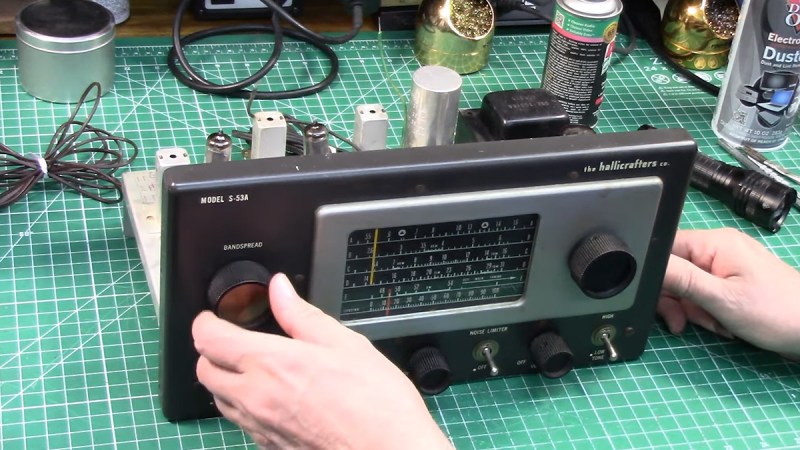Shortwave radio has a charm all its own: part history, part mystery, and a whole lot of tech nostalgia. The Hallicrafters S-53A is a prime example of mid-century engineering, but when you get your hands on one, chances are it won’t be in mint condition. Which was exactly the case for this restoration project by [Ken’s Lab], where the biggest challenge wasn’t fried capacitors or burned-out tubes, but a stubborn band selector switch that refused to budge.
What made it come to this point? The answer is: time, oxidation, and old-school metal tolerances. Instead of forcing it (and risking a very bad day), [Ken]’s repair involved careful disassembly, a strategic application of lubricant, and a bit of patience. As the switch started to free up, another pleasant surprise emerged: all the tubes were original Hallicrafters stock. A rare find, and a solid reason to get this radio working without unnecessary modifications. Because some day, owning a shortwave radio could be a good decision.
Once powered up, the receiver sprang to life, picking up shortwave stations loud and clear. Hallicrafters’ legendary durability proved itself once before, in this fix that we covered last year. It’s a reminder that sometimes, the best repairs aren’t about drastic changes, but small, well-placed fixes.
What golden oldie did you manage to fix up?
















I have one of those stashed away and I just checked the band switch and it clicks! A similar model with series tubes I have at work was last on every day for the Christian Science Monitor’s 2 hour global news during the gulf war. CSM with 3 sites covered the world, that was one of the best now gone. At that time Purdue lost NPR. Unless I did FM DX, AM-SW that was all there was. Some powerful religious SW broadcasters are in Indiana, so there’s little else now.
A firmly locked Vice-Grip is the best way to carefully move something that’s stuck. Move barely at first watching for motion that’s not stripping or breaking. Wiggling and solvent usually gets it when you can’t torch it hot.
WWV is always good for a time sync because broadcast radio is full of time delayed web feeds with digital STL’s but will it survive all the slashing?
There is plenty to listen to on broadcast shortwave today. I listen 8-12 hours a day with English broadcasts from outside of the US. There hasn’t been any religious shortwave out of Indiana for years. Maybe you should turn a radio on….
There are still plenty of affordable S-53A’s on Ebay if you are up for a restoration project. Here are the manuals free to download from the Boat Anchor Manual Archive (BAMA):
https://bama.edebris.com/manuals/hallicra/s53a/
The wiring was such a mess back then.
Not that I don’t like “3D wiring” per se or don’t realize that it can be effective, but there’s no cable managment, at all.
It’s just a mess, lile in a Junost TV from USSR.
I’m so glad that PCBs and modular designs had superseded this.
The Japanese amateur radios from the 1970s were much cleaner built, for example.
Yaesu FT-101 comes to mind spontaneously.
Oh, and these old radios also seem to lack “chamber technique”.
Industrial or military grade radios would use separate, grounded metal chambers for each oscillator, amplifier etc.
The cables may pass through tiny holes (sometimes insulated with rubber rings) of each chamber.
The cables themselves would been bundled together with strings.
All of that cost money, and no need for any of it.
Doesn’t make the radio work any better.
Not to mention no lifted traces.
I use to laugh at wannabee” techs who hated working on consumer electronics.
They had not trained their soldering irons to stay away from plastic insulation.
/Sue needs to restore that SX-62 sitting on the dresser.
Hm. I’ve seen radios built by amateurs on a kitchen table that had better circuit design than these old commercial made radios.
And yes, these people propably had no money on mind. And I think that’s good.
It wasn’t until the 70’s where PCBs became good enough. Early phenolic PCBs would occasionally have copper traces lift during normal use. Almost certain to happen during rework.
These were more or less consumer grade radios. Hallicrafters made some very good pre WW-II amateur equipment and they also made some very good military equipment for the War. Collins was more technical though. I had the military version of the Collins 51-J3 that I got at the Dayton in the 1980s. That was 30 1 MHz bands from 0 to 30 MHz. The band switching was a mechanical marvel. I probably shouldn’t have sold it, but a friend really wanted that radio.
Nice looking receiver.
What are people liking these days for restoring old selector switches – Caig DeOxIt D5?